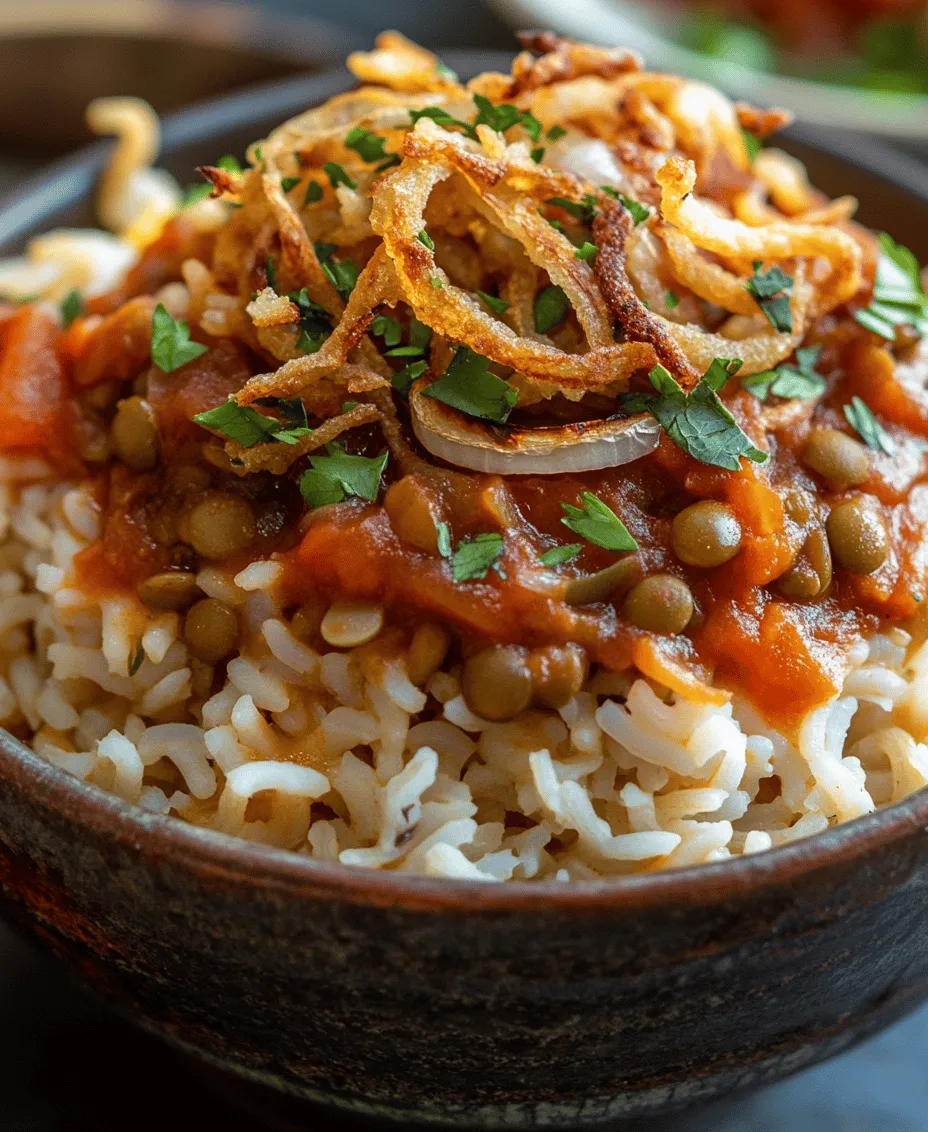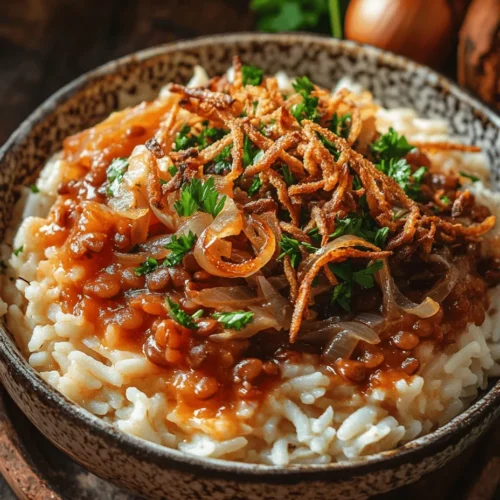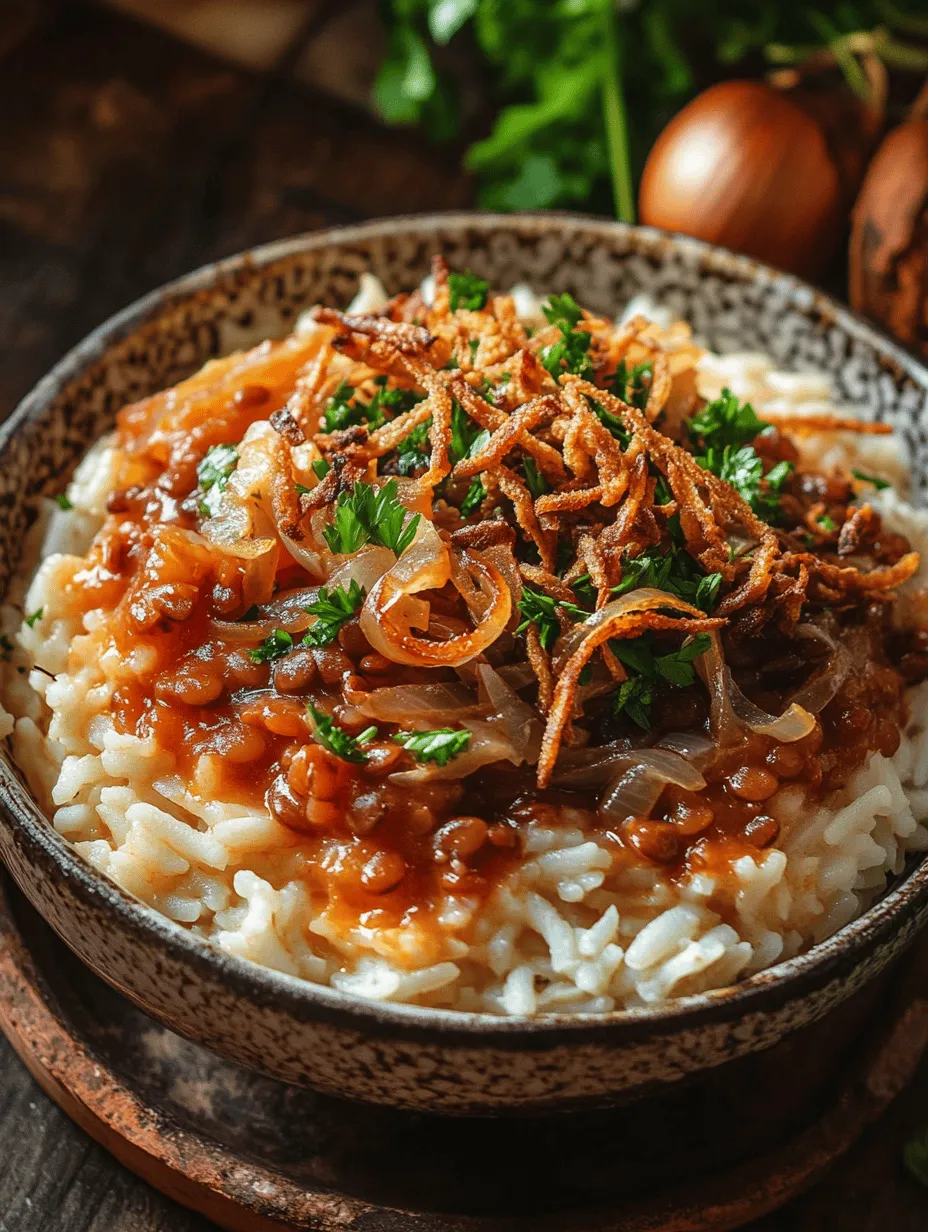Introduction
Exploring the world through food is one of life’s greatest pleasures, and Koshari Delight is a perfect gateway into the rich culinary traditions of Egypt. This iconic dish is a hearty blend of brown lentils, rice, elbow macaroni, and a tangy tomato sauce, garnished with crispy fried onions and fresh parsley. Each component comes together to create a satisfying and flavorful meal that reflects the diverse ingredients and culinary heritage of Egyptian cuisine.
Koshari, often referred to as the national dish of Egypt, is more than just a meal; it’s a symbol of the country’s history and culture. From its humble beginnings as a street food favorite to its status as a beloved staple in homes and restaurants across Egypt, Koshari has woven itself into the fabric of Egyptian life. In this article, we will delve into the history of Koshari, its cultural significance, and provide a detailed recipe to help you recreate this delicious dish in your own kitchen.
Understanding Koshari: A Cultural Icon
The Origins of Koshari
The origins of Koshari can be traced back to the 19th century in Egypt, where it emerged as a popular street food among the working class. The dish was created out of necessity, combining readily available ingredients into a filling and affordable meal. Its foundation lies in the mix of lentils, rice, and pasta, reflecting the culinary influences of various cultures that have intersected in Egypt over the centuries, including Italian, Indian, and Middle Eastern cuisines.
As Egypt modernized, Koshari transcended its humble roots and became a cherished national dish. Today, you can find Koshari being served in restaurants ranging from street vendors to upscale dining establishments. Its popularity has only increased over the years, and it is often seen as a comfort food that evokes feelings of nostalgia for many Egyptians.
Different regions of Egypt have their own variations of Koshari, showcasing local ingredients and culinary preferences. Some regions may include chickpeas, while others might add fried eggplant or different spices. Despite these variations, the essence of Koshari remains the same: a delicious and hearty dish that brings people together.
The Ingredients That Make Koshari Special
Koshari’s appeal lies not only in its rich history but also in its unique blend of ingredients that create a symphony of flavors and textures. The key components of Koshari include lentils, rice, and elbow macaroni, each playing a vital role in the dish’s overall character.
– Lentils: Brown lentils are the star of Koshari, providing a robust source of protein and fiber. They are cooked until tender but still firm, ensuring they hold their shape and add a hearty element to the dish. The earthy flavor of the lentils complements the other ingredients perfectly.
– Rice: The rice used in Koshari is typically long-grain, which absorbs flavors beautifully. The rice is often sautéed before cooking to enhance its flavor and achieve a fluffy texture. When combined with the lentils and pasta, it creates a satisfying base for the dish.
– Elbow Macaroni: The addition of elbow macaroni adds a delightful texture and a hint of chewiness. This pasta component is essential for achieving the classic Koshari experience, as it contributes to the overall heartiness of the dish.
– Spices: Spices are crucial in elevating Koshari’s flavor profile. Cumin, coriander, and paprika are commonly used to add warmth and depth to the dish. These spices not only enhance the taste but also contribute to the aromatic experience of enjoying Koshari.
– Tomato Sauce and Garnishes: A tangy tomato sauce is poured over the assembled Koshari, providing a burst of acidity that balances the richness of the lentils and pasta. Crispy fried onions and fresh parsley are then sprinkled on top, adding a delightful crunch and a pop of color.
The combination of these ingredients creates a dish that is not only delicious but also nutritious, making Koshari a well-rounded meal that can be enjoyed any time of the day.
Preparing Koshari Delight: A Step-by-Step Guide
To recreate the authentic flavors of Koshari in your own kitchen, it’s essential to gather the right ingredients and follow a carefully crafted process. Below, we outline the steps to prepare this delightful dish.
Gathering Your Ingredients
Before you begin cooking, it’s important to gather all the necessary ingredients for Koshari. Below is a detailed list of what you’ll need:
Ingredients List:
– For the Koshari:
– 1 cup brown lentils
– 1 cup long-grain rice
– 1 cup elbow macaroni
– 4 cups water (for boiling)
– 1 large onion, thinly sliced
– 1/4 cup vegetable oil (for frying onions)
– Salt and pepper to taste
– For the Tomato Sauce:
– 2 cups canned diced tomatoes (or fresh, peeled and chopped)
– 2 tablespoons tomato paste
– 1 teaspoon cumin
– 1 teaspoon coriander
– 1/2 teaspoon paprika
– 2 cloves garlic, minced
– Salt and pepper to taste
– Garnishes:
– Fresh parsley, chopped
– Crispy fried onions (store-bought or homemade)
Notes on Sourcing:
– When selecting lentils, opt for brown lentils as they hold their shape well during cooking. Look for firm, unblemished lentils.
– For rice, choose a long-grain variety that will provide the desired fluffy texture. Jasmine or basmati rice are excellent choices.
– Ensure your elbow macaroni is of good quality; it should be firm and not overly processed.
– Fresh herbs like parsley should be vibrant in color and free from wilting or browning.
Cooking the Lentils
Lentils are a cornerstone of Koshari, and achieving the perfect texture is key. Follow these steps for optimal results:
1. Rinse the Lentils: Start by placing the lentils in a fine-mesh sieve and rinsing them under cold running water. This helps remove any dust or impurities, ensuring a cleaner flavor.
2. Cook the Lentils: In a medium pot, add the rinsed lentils and enough water to cover them by about an inch. Bring it to a boil over medium-high heat, then reduce the heat to low and let them simmer uncovered for about 15-20 minutes, or until the lentils are tender but still hold their shape. Be sure to check for doneness periodically.
3. Season: Once cooked, drain any excess water, if necessary, and season the lentils with salt and pepper to taste. Set aside while you prepare the rice and macaroni.
Preparing the Rice
The rice in Koshari adds a fluffy texture that complements the dish beautifully. Here’s how to prepare it:
1. Sauté the Rice: In a large pot, heat a tablespoon of vegetable oil over medium heat. Add the rice and sauté for about 2-3 minutes, stirring frequently until the grains are slightly translucent and fragrant.
2. Add Water: Pour in 2 cups of water, bringing the mixture to a boil. Once boiling, reduce the heat to low and cover the pot with a tight-fitting lid. Allow the rice to cook for about 15 minutes or until all the water is absorbed.
3. Fluff the Rice: After the cooking time, remove the pot from heat and let it sit covered for an additional 5 minutes. Fluff the rice gently with a fork to separate the grains and incorporate the sautéed flavor.
Cooking the Elbow Macaroni
The macaroni in Koshari adds a delightful texture, and cooking it to the right level of doneness is essential.
1. Boil Water: In a separate pot, bring water to a boil. Add a pinch of salt to the water to flavor the pasta as it cooks.
2. Cook the Macaroni: Add the elbow macaroni to the boiling water and cook according to package instructions, usually about 7-9 minutes for al dente. Stir occasionally to prevent sticking.
3. Drain and Rinse: Once cooked, drain the macaroni in a colander and rinse it under cold water to stop the cooking process. This step is particularly important to maintain the desired texture.
Creating the Tomato Sauce
The tomato sauce is the finishing touch that brings all the elements of Koshari together.
1. Sauté Aromatics: In a saucepan, heat a tablespoon of oil over medium heat. Add the minced garlic and sauté for about 30 seconds until fragrant but not browned.
2. Add Tomatoes: Stir in the diced tomatoes and tomato paste, mixing well. Season with cumin, coriander, paprika, salt, and pepper. Allow the sauce to simmer for about 10-15 minutes, stirring occasionally, until it thickens slightly and the flavors meld together.
3. Adjust Seasoning: Taste the sauce and adjust the seasoning as needed. If you prefer a spicier kick, you can add a pinch of cayenne pepper or a splash of hot sauce.
With all the components ready, you’ll be well on your way to assembling your Koshari Delight. The following sections will guide you through the final steps of combining these ingredients to create this delicious dish, ensuring an authentic Egyptian dining experience in your own home.

Step-by-Step Breakdown of Sautéing Onions and Garlic
The key to a flavorful Koshari lies in the depth of its base ingredients. Sautéing onions and garlic is an essential step that infuses the dish with sweetness and aromatic richness. Begin by heating a generous amount of vegetable oil in a large skillet over medium heat. You want enough oil to coat the bottom of the skillet, allowing the onions to caramelize beautifully without burning.
1. Add the Onions: Once the oil is shimmering, add thinly sliced onions. Sauté them gently, stirring occasionally, until they turn a lovely golden brown. This process can take about 10-15 minutes. Patience is crucial here, as the natural sugars in the onions will caramelize and deepen in flavor.
2. Incorporate Garlic: After the onions have softened and caramelized, add minced garlic to the skillet. Sauté for an additional 1-2 minutes, until the garlic is fragrant but not browned. Burnt garlic can impart a bitter taste, so keep a close eye on it.
The combination of sweet onions and fragrant garlic serves as a robust flavor foundation for your Koshari. This step enhances the overall taste and ensures that every bite is packed with savory goodness.
Importance of Simmering to Develop Depth of Flavor
Once you’ve prepared your sautéed onions and garlic, the next crucial step is to simmer the tomato sauce. This is where the magic happens. Pour in your canned tomatoes, tomato paste, and the spices (cumin, coriander, and salt) into the skillet with the sautéed mixture. Allow the sauce to come to a gentle boil, then reduce the heat to low and let it simmer.
Simmering allows the flavors to meld beautifully. Aim for at least 20-30 minutes of simmering. Stir occasionally to prevent sticking. As the sauce cooks, it will thicken and the flavors will intensify, creating a deliciously rich topping for your Koshari.
Adjusting Seasoning to Personal Taste
As your sauce simmers, taste it periodically. This is your opportunity to adjust the seasoning to your liking. If you prefer a spicier kick, consider adding a pinch of cayenne pepper or some chopped fresh chili. For a hint of sweetness, a small amount of sugar can balance the acidity of the tomatoes. Adjust salt and pepper according to your preferences, ensuring the sauce complements the other layers of the dish.
Assembling the Dish
Now that your base flavors are ready, it’s time to assemble the Koshari for serving. The layering is not only important for flavor, but also for visual appeal.
Layering Techniques for Visual Appeal and Flavor Distribution
1. Start with the Rice and Lentils: In a large serving dish, begin by placing a layer of cooked rice at the bottom. Next, add a layer of lentils. The rice serves as a soft foundation, while the lentils add texture.
2. Add the Macaroni: After the lentils, layer the cooked macaroni. This combination of textures is vital for an authentic Koshari experience.
3. Pour on the Sauce: Carefully pour the simmered tomato sauce over the layered ingredients. To avoid sogginess, drizzle the sauce in a circular motion, allowing it to coat the layers without completely saturating them. This technique ensures that each bite retains a balance of flavors and textures.
Garnishing and Serving Koshari
Garnishing elevates the presentation of your Koshari and enhances its flavors.
The Role of Crispy Fried Onions and Fresh Parsley
To finish off your dish, top it with a generous amount of crispy fried onions. These add a delightful crunch and a burst of flavor that contrasts beautifully with the softness of the rice and lentils. Additionally, sprinkle fresh parsley over the top for a pop of color and freshness. The parsley not only brightens the dish visually but also provides a hint of herbal flavor that complements the rich sauce.
Presentation Suggestions for an Inviting Serving Platter
For an inviting presentation, consider serving Koshari in a large, shallow platter. This allows the layers to be visible, creating an appealing display. Arrange some extra crispy onions on the side for guests to add as they please. You might also serve alongside a small bowl of extra tomato sauce for those who enjoy a saucier dish.
Nutritional Aspects of Koshari
Koshari is not only delicious but also packed with nutritional benefits, making it a satisfying meal option.
Health Benefits of Koshari
1. Nutritional Breakdown of the Main Ingredients: Koshari’s primary components—lentils, rice, and macaroni—offer a balanced mix of carbohydrates and protein. Lentils are particularly rich in protein and fiber, making them an excellent choice for maintaining fullness and supporting digestive health.
2. High Fiber Content: The combination of lentils and whole grain rice contributes to a high fiber content, which is essential for a healthy digestive system. This fiber aids in regulating blood sugar levels and can help with weight management.
Dietary Considerations
Koshari is a versatile dish that can easily accommodate various dietary preferences:
1. Considerations for Vegetarian and Vegan Diets: Koshari is inherently vegetarian and can be made vegan by using plant-based oils and avoiding non-vegan toppings. This makes it a great option for those following a plant-based diet.
2. Gluten-Free Adaptations for Macaroni: For gluten-sensitive individuals, gluten-free macaroni can be substituted to ensure that everyone can enjoy this hearty meal without worry.
Koshari in Contemporary Cuisine
Koshari is gaining popularity beyond Egypt, making its mark on the global culinary scene.
Koshari Beyond Egypt
1. How Koshari is Being Embraced in Global Cuisine: Many chefs from diverse culinary backgrounds are incorporating Koshari into their menus, adding unique twists that highlight local ingredients. In cities with large Egyptian communities, Koshari shops have sprung up, offering this beloved dish to a wider audience.
2. Restaurants and Chefs Putting Their Spin on This Classic Dish: From upscale restaurants to street food vendors, Koshari is being reinterpreted. Some chefs experiment with gourmet ingredients or modern plating techniques, while others maintain the traditional style, showcasing its cultural heritage.
Creative Variations of Koshari
1. Exploring Ingredient Substitutions for Dietary Needs: As Koshari becomes more popular, variations have emerged. For those looking for a protein boost, adding chickpeas or grilled vegetables can enhance the dish while keeping it balanced.
2. Innovative Twists on Traditional Koshari Recipes: Some recipes introduce different sauces, such as tahini or yogurt, for drizzling on top. Others might include spices like smoked paprika or za’atar to give it a unique flair while still preserving the essence of the dish.
Conclusion
Koshari Delight is more than just a meal; it is a celebration of Egyptian culture and culinary heritage. With its comforting layers of lentils, rice, and macaroni, all enveloped in a rich tomato sauce, it is a dish that brings people together. By following this comprehensive guide, you can bring the flavors of Egypt into your home and share this delightful experience with friends and family. Enjoy the journey of cooking and the pleasure of tasting this iconic dish. Embrace the warm, inviting aromas and the comforting textures of Koshari, and let it inspire cherished gatherings around your table.



